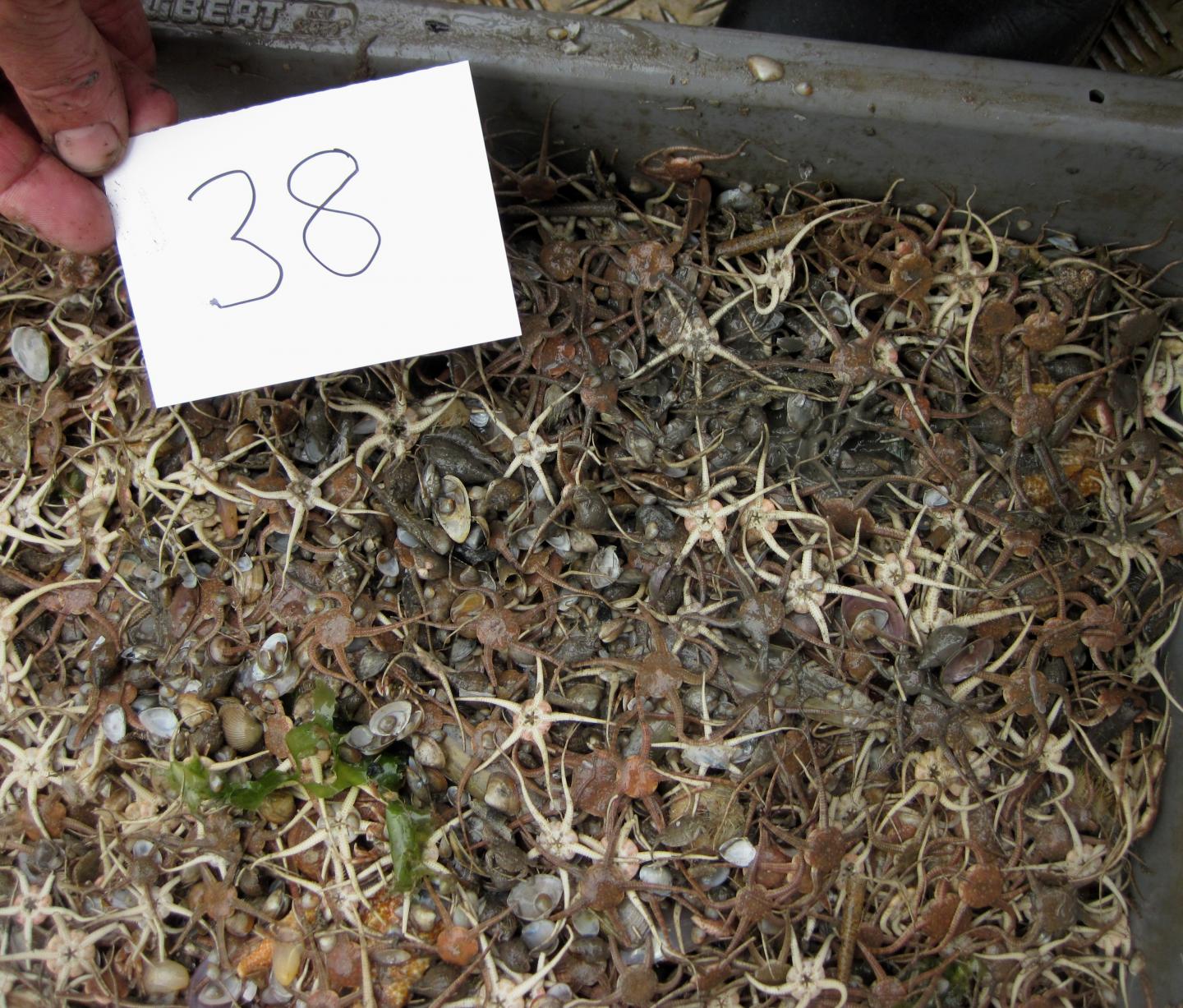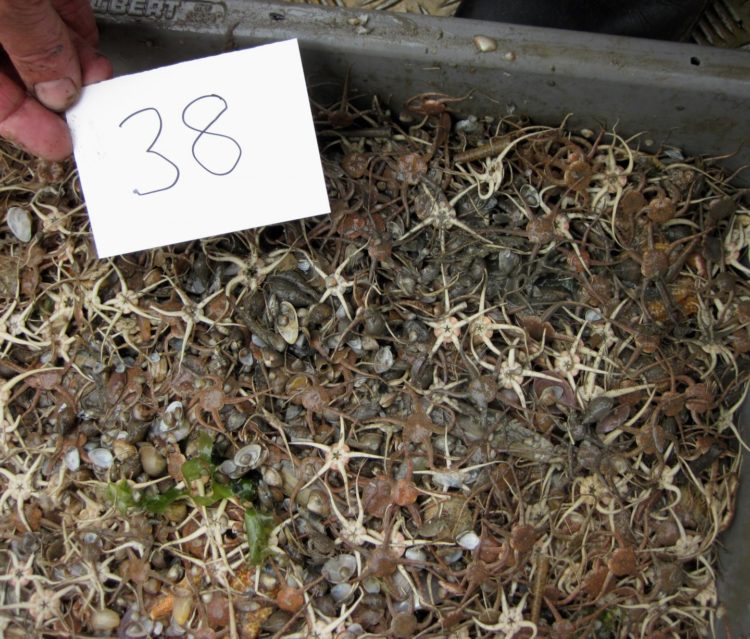Study of over 170 species in Swansea Bay, Wales

Credit: Ruth Callaway/Swansea University
The biggest impacts on the sea life in Swansea Bay, Wales, come from waves and tides rather than human activity, a wide-ranging new study – encompassing over 170 species of fish and other sea life such as crabs, squid and starfish – has revealed.
Combining data on species, human impacts, and wave and tide patterns, the study, by a Swansea University team, provides the most comprehensive picture to date of the factors that drive change in Swansea Bay. It will give planners a better understanding of the Bay and of the potential impacts of new developments on its ecosystem.
With its two urban centres in Swansea and Port Talbot, Swansea Bay is home to around 290,000 people and is a centre for industry, including a large steelworks and two ports. It has the second highest tidal range in the world, as Atlantic tides are funnelled into the narrowing Bristol Channel and then spread across the shallow bay.
For scientists studying what’s happening to the environment, highly-urbanised coastal areas like Swansea Bay present a problem. There are so many different natural and human influences on the environment that it can be difficult to disentangle them, or to work out which are the most significant.
Yet without this knowledge of the full picture, planners and environmental managers cannot make the best decisions about ecological impact.
This is where the new research comes in. The Swansea team, which included a biologists and engineers, gathered data on species, human impacts and wave and tide patterns and fed it into a statistical model. This meant they could then assess the significance of different factors.
They found that:
- The waves and tides had a bigger impact on the Bay than human activity
- Waves and tides accounted for over half of all the variation in species that was observed
- Different species were affected by different factors, and to varying degrees – for example, dredge spoil disposals had the biggest impact on fish, whereas marine life was not affected by wastewater discharge.
The impetus for this study came from the tidal lagoon project, which revealed that there were gaps in our understanding of Swansea Bay, a highly-used, urbanised coastal ecosystem. So the Swansea University team, who had been working on separate studies, joined forces to produce this new research as part of SEACAMS, an EU-funded initiative focusing on marine renewable energy.
Dr Ruth Callaway of the College of Science at Swansea University, who led the work, said:
“It may be a surprise given that it is a highly-urbanised area, but the biggest impact on the ecology of Swansea Bay are the waves and tides. Our research shows that these natural factors shape the marine life more than human activity, such as wastewater discharge and discarding dredged material.
However, Swansea Bay remains a complex ecosystem that has been changed dramatically over the past centuries, and we need as full a picture as possible of impacts on it. That’s what our research findings will help to provide.”
Dr Callaway underlined how the scope of the research allowed them to build a comprehensive picture:
“What is new about this research is that we used a combination of computer models and empirical field data: we examined the wave environment and tidal currents and measured various natural and human factors.
We also studied a wide range of species. Often judgement about ecological quality and environmental impact is based on a sub-set of coastal fauna, for example the biodiversity of small animals living inside the seafloor sediments. In contrast, our investigation also included fauna living on top of the seafloor, revealing significant differences between the different groups.”
Dr Iain Fairley, of Swansea University College of Engineering, who modelled the wave environment of the Bay, said:
“The high correlation between both hydrodynamic models of this study and each of the surveyed faunal communities confirmed that good quality three-dimensional environmental models can be useful tools in understanding the distribution of marine life. They are important tools to support ecosystem management, particularly in areas with complex, highly variable hydrodynamic patterns.”
Dr Jose Horrillo-Caraballo, also of the College of Engineering, added:
“In the paper we discuss the balance between the hydrodynamic regime and anthropogenic factors in shaping the biota. We touch on the question of resistance of an ecosystem to change, but also differentiate between the current and historical situation.”
The research was published in “Science of the Total Environment“.
###
Notes to Editors
Read the research paper: authors: Ruth Callaway, Iain Fairley, Jose Horrillo-Caraballo, Swansea University. Published in Science of the Total Environment
About SEACAMS: Now in its second phase, SEACAMS2 is a £17 M project partnership between Bangor and Swansea universities, part funded by the European Regional Development Fund. The main objective of SEACAMS2 is to assist the development of opportunities in ‘Low carbon, Energy and Environment’ in Wales, focussing on marine renewable energy. The Colleges of Engineering and Science jointly approached questions about the Swansea Bay ecosystem.
Swansea University is a world-class, research-led, dual campus university offering a first class student experience and has one of the best employability rates of graduates in the UK. The University has the highest possible rating for teaching – the Gold rating in the Teaching Excellence Framework (TEF) in 2018 and was commended for its high proportions of students achieving consistently outstanding outcomes.
Swansea climbed 14 places to 31st in the Guardian University Guide 2019, making us Wales’ top ranked university, with one of the best success rates of graduates gaining employment in the UK and the same overall satisfaction level as the Number 1 ranked university.
The 2014 Research Excellence Framework (REF) 2014 results saw Swansea make the ‘biggest leap among research-intensive institutions’ in the UK (Times Higher Education, December 2014) and achieved its ambition to be a top 30 research University, soaring up the league table to 26th in the UK.
The University is in the top 300 best universities in the world, ranked in the 251-300 group in The Times Higher Education World University rankings 2018. Swansea University now has 23 main partners, awarding joint degrees and post-graduate qualifications.
The University was established in 1920 and was the first campus university in the UK. It currently offers around 350 undergraduate courses and 350 postgraduate courses to circa 20,000 undergraduate and postgraduate students. The University has ambitious expansion plans as it moves towards its centenary in 2020 and aims to continue to extend its global reach and realise its domestic and international potential.
Swansea University is a registered charity. No.1138342. Visit http://www.
For more information:
Kevin Sullivan,Swansea University Public Relations Office
Tel: 01792 513245, [email protected]
Media Contact
Kevin Sullivan
[email protected]
01-792-513-245
Related Journal Article
http://dx.





